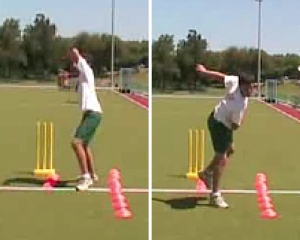How to Coach More Spin into Spinners
W here does spin come from?
here does spin come from?
Ask any spinner or any coach this question and you can get a huge number of answers ranging from the pivot of the foot, through to the angle of the delivery stride.
This is largely to do with the open question. A better question is,
"which part of the body has the most significant role to play when generating spin?"
Here's what I think.
Is it the fingers?
My grandad was a cricket tragic, and proud of it. I used to hang on to every word when he recited stories of Bradman, Sobers, Hall and others of bygone eras. One of the stories that I recall was about the great West Indian spinner, Lance Gibbs.
Lance Gibbs took 309 Test wickets at under 30 a piece. The secret to his prodigious break off the pitch was down to his long fingers, according to my Grandad. Fingers are the last part of the kinetic chain and the point of contact with the ball. So yes, they play a big role in spin.
TV commentators tend to look at what spinners wrists and fingers are doing on video screens: They concentrate on the last bit of the chain. But are they the most important part in the generation of spin?
Get those hips going
Recent research has shown that the hips play a massive role in producing spin and it makes total sense considering the role that hips play in the kinetic chain when bowling fast, throwing and hitting with power.
Most of the recent effective spinners in the game move their hip from a nearly sideways position in their delivery stride through 90 degrees or more to a beyond square position at point of release. This rotation of the hips and then the subsequent slowing and stabilising of the hip girdle assists optimal transfer of momentum up the kinetic chain into the shoulders, arms and then into the fingers. This creates the speed in the fingers that allows the ball to rotate like a top.

Without the hip working in this fashion, the momentum transfer through the body will be less effective and therefore, less speed will end up at the end of the kinetic chain (the fingers). The net result is less rotations on the ball.
Great examples of this hip rotation process are evident in the actions of Graeme Swann (slightly open hip in delivery stride to right hip beyond square ahead of release), Shane Warne and Stuart McGill.
Coaching more spin
If you work a bowler who wants to spin the ball more then start with the hips.
Analyse how effectively they are working first. If the answer is "not very", then get the bowler to bowl from a back foot position. Start where the intention is to get the bowling side hip to rotate beyond square ahead of release.
- After a few goes, the bowler should experience increased spin from this standing start and extra hip emphasis.
- Once the bowler feels comfortable enough with this then you apply a couple of steps approach into the delivery stride.
- Again, wait until the bowler feels comfortable yet able to maintain the hip rotation and add a bit more to the approach until it resembles a normal run up.
Be patient, this change in movement pattern can take time yet the results are career changing.
- Login to post comments


Comments
Biomechanically, there are three ways of generating rotations on a spherical object at the point of release: by applying asymmetric pressure from the fingers, through the flexion or extension of the wrist, or the use of arm speed applied along a vector that doesn't pass through the centre of the ball by means of a non-neutral shoulder alignment during the critical phase of the bowling action.
a) is finger spin
b) is wrist spin
c) is a cutter
I guess what Mark is saying is that the use of the hips is important in generating arm speed without compromising on shoulder alignment and so helps with method c). I think this should be made clear, else we're going to end up with the situation where people think the movement of the hips actually have a direct effect onto the ball through some kind of magical action at a distance, which is clearly nonsense.